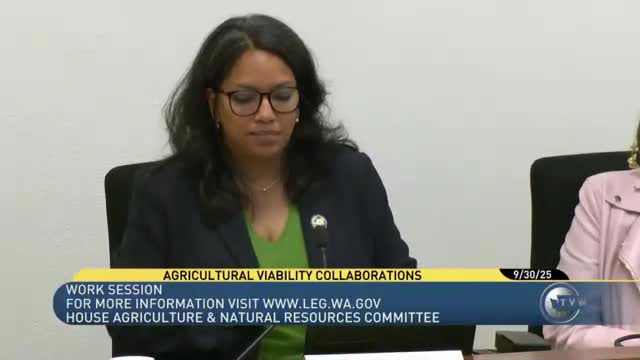State agriculture director outlines programs, pest threats and export markets amid farm losses
September 30, 2025 | Legislative Sessions, Washington
This article was created by AI summarizing key points discussed. AI makes mistakes, so for full details and context, please refer to the video of the full meeting. Please report any errors so we can fix them. Report an error »

Derek Sandison, director of the Washington State Department of Agriculture, told the House Agriculture & Natural Resources Committee that the department enforces phytosanitary inspections, implements the Food Safety Modernization Act at the state level, manages pesticide and fertilizer registration, and conducts plant and animal disease control. He said the department also supports marketing and food access programs.
Sandison summarized key state agriculture statistics from the 2022 Census of Agriculture: 32,076 farms in Washington, down from about 35,700 in 2017. He said 82% of farms are less than 180 acres and that the median farm in the dataset is roughly 30 acres with a net income estimate of about $5,000, stressing that about 90% of total farm-gate value is produced by roughly 10% of farms. Sandison placed Washington’s aggregate crop value at about $12,000,000,000 and identified apples as the single largest crop at about $2,000,000,000 in value.
On export markets, Sandison said Canada is Washington’s largest buyer, followed by Japan and Mexico. He noted frozen potatoes, fish and seafood, apples, wheat and dairy among the state’s top exports and said the USMCA regional market framework is important for Washington producers.
Sandison also listed the department’s active programs and priorities aimed at supporting viability: farm-to-school purchasing grants, infrastructure grants for mid-supply-chain improvements, local food purchase assistance (a USDA program), targeted efforts for underrepresented farmers, international market work and pest and disease response. He told the committee the department is combating Japanese beetle in Yakima Valley, managing responses to highly pathogenic avian influenza outbreaks, completed eradication work on the northern giant hornet and conducts surveillance for pests not yet present, including spotted lanternfly.
He said the department has contributed to a vacant-lands analysis to identify land that could help new and entry-level farmers access property, and that climate resilience programming and the STAR (Saving Tomorrow’s Agricultural Resources) program are underway as part of state climate resilience planning.
Sandison said the department is reviewing the WSU competitiveness analysis with internal and external stakeholders and expects to publish an interim report in December and a final report by June 2026.
Sandison summarized key state agriculture statistics from the 2022 Census of Agriculture: 32,076 farms in Washington, down from about 35,700 in 2017. He said 82% of farms are less than 180 acres and that the median farm in the dataset is roughly 30 acres with a net income estimate of about $5,000, stressing that about 90% of total farm-gate value is produced by roughly 10% of farms. Sandison placed Washington’s aggregate crop value at about $12,000,000,000 and identified apples as the single largest crop at about $2,000,000,000 in value.
On export markets, Sandison said Canada is Washington’s largest buyer, followed by Japan and Mexico. He noted frozen potatoes, fish and seafood, apples, wheat and dairy among the state’s top exports and said the USMCA regional market framework is important for Washington producers.
Sandison also listed the department’s active programs and priorities aimed at supporting viability: farm-to-school purchasing grants, infrastructure grants for mid-supply-chain improvements, local food purchase assistance (a USDA program), targeted efforts for underrepresented farmers, international market work and pest and disease response. He told the committee the department is combating Japanese beetle in Yakima Valley, managing responses to highly pathogenic avian influenza outbreaks, completed eradication work on the northern giant hornet and conducts surveillance for pests not yet present, including spotted lanternfly.
He said the department has contributed to a vacant-lands analysis to identify land that could help new and entry-level farmers access property, and that climate resilience programming and the STAR (Saving Tomorrow’s Agricultural Resources) program are underway as part of state climate resilience planning.
Sandison said the department is reviewing the WSU competitiveness analysis with internal and external stakeholders and expects to publish an interim report in December and a final report by June 2026.
View full meeting
This article is based on a recent meeting—watch the full video and explore the complete transcript for deeper insights into the discussion.
View full meeting
